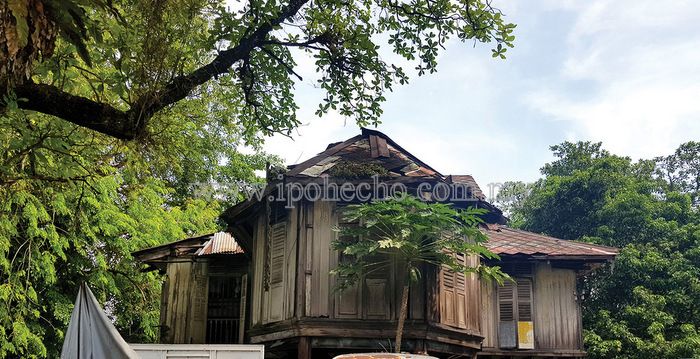

After the death of the tenth Dato’ Panglima Kinta Mohamed Yusuf in 1903, Dato’ Sri Adika Raja, Wan Mohamed Salleh became the richest and most influential Malay in Ipoh.
He was born in 1861. At 20, he entered the service of the Perak Government as a Malay writer. He was for a time Superintendent of Penghulus in the Ulu Kuala Kangsar district and, in 1902, was appointed Assistant Collector of Land Revenue.
He took up residence in Ipoh after his marriage with Toh Puan Sharifah Rodiah, the widow of the eleventh Dato’ Panglima Kinta Abdul Wahab. With the new Dato’ Muda Che Wan Bin Mohamed Yusuff, who later became the 12th Dato’ Panglima Kinta, Ipoh had two able Malay leaders who looked after the welfare of their constituents.
The Malay settlements in Ulu Kinta are flourishing. Mr Worthington, the then Assistant District Officer said that Che Wan, the new Dato’ Muda of Kinta, stepped in and took over the debts due by Malays to a Chetty, thereby conferring a benefit of which the reduced interest was a very important fraction. The Settlements wanted an influential Kinta Malay to take an interest in them. The improvement in the condition of the Kinta Malays is due chiefly to the influence of one or two leading men with a strong national spirit. Whatever the reason the result is remarkable. The Residents remarks that one great factor in this improvement has been that Dato’ Sri Adika Raja has taken up permanent residence in Ipoh.
The Dato’ Sri Adika Raja was an entrepreneur in the mould of Dato’ Mohamed Yusuff. He built a number of townhouses on Hale Street, each with a nice little plot of land in front for a garden, and a driveway wide enough for a horse-drawn carriage. This was a most picturesque site, facing the Padang and almost exactly behind the Chartered Bank’s premises.
In 1909, the FMS Government established a Malay Settlement in Ipoh behind the new market in Leech Street, known as Kampung Pasar Bharu. A new bridge was built across the Kinta River close to Patrick Street near the market. The road leading to the settlement, later called Jalan Datoh, opened up many fine building sites. The lots were rapidly taken up by many of the leading Malays of Ipoh, including the Dato’ Sri Adika Raja, the Dato’ Muda and other chiefs, the river location being especially popular with the Malay community.
In 1912, HH Sultan Idris Shah, accompanied by the Raja Permaisuri and suite, paid a short visit to Ipoh, as guests of the Dato’ Sri Adika Raja. He was so pleased with everything, especially the exceeding cleanliness of the town that he decided to build an Istana in Ipoh. He had already selected a very recherché site in the well-laid-out Malay Settlement.


His Highness in Ipoh
HH had known Ipoh since the time when there was only a small kampong on the river bank, and now, when he came to visit after having reigned for 25 years, he found the makings of a great city. HH had enjoyed his visit so much that he decided to build himself an Istana in the delightful Malay kampong where the Dato’ Sri Adika Raja lived.
The Dato’ Sri Adika Raja certainly made a difference to Ipoh since deciding to make it his home. In September 1909, PZ Creet of Penang came to Ipoh to see about the feasibility of opening a first class hotel in the town. He entered into negotiations with the Dato’ Sri Adika Raja for a long lease of his residence in Lahat Road with its spacious grounds. The property was built by Dato’ Abdul Wahab in 1894.
After considerable renovations, the Grand Hotel opened its doors to the public on December 16, 1909. The timing was perfect. Fuelled by both tin and rubber booms, the hotel enjoyed a high occupancy rate.
In 1912, the Dato’ Sri Adika Raja, on Creet’s suggestion, built an annexe of ten suites of rooms along the most modern lines. Each suite comprised a bedroom with verandah. The whole complex was lit by “simpetrol” gas.
The following year the Dato’ built another annexe of ten rooms with a large dining room, entirely lit by electricity, making the Grand one of the finest hotels in the Straits Settlements and Federated Malay States.
The Dato’ Sri Adika Raja was one of the few locals who mixed with Europeans on an equal footing. He was a skilled chess player who had beaten many Europeans at Ipoh Club competitions.
He was also a good billiard player and was often the only Asian to enter the Ipoh Club Billiard Tournament.
Ho Tak Ming
Postscript
Ipoh Echo visited the Dato’ Sri Adika Raja mansion on Saturday, February 23. Ownership of the building has now changed hands. The new owner has rented it out.


